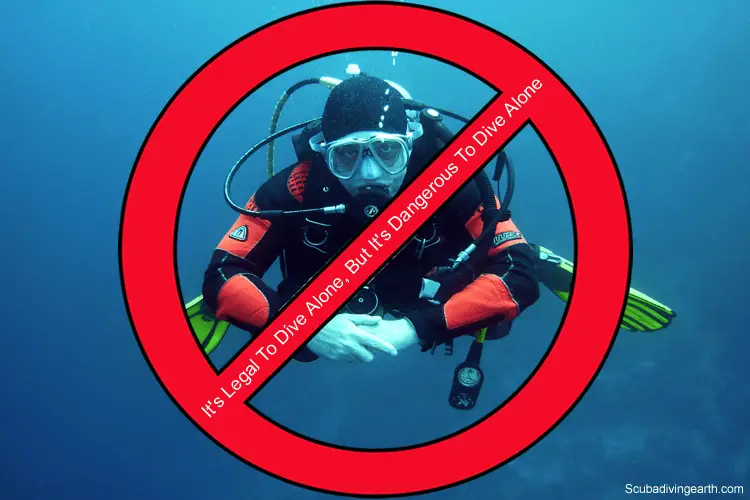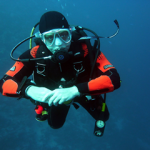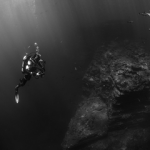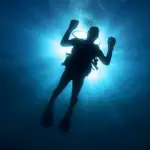
The 3 main dangers of diving are decompression sickness (DCS) as a result of ascending too fast, barotrauma caused by pressure changes and by divers holding their breath when ascending, plus nitrogen narcosis which affects divers on deep dives where judgement can be impaired or divers get confused.
Scuba diving is an adventurous and exhilarating activity, but it also carries certain risks. Here are three dangers associated with scuba diving:
- Decompression Sickness (DCS): DCS, commonly known as “the bends,” occurs when a diver ascends too quickly, leading to the formation of nitrogen bubbles in the body tissues. Symptoms can range from joint pain and rashes to more severe conditions affecting the nervous system, lungs, or heart. To mitigate the risk of DCS, divers must adhere to safe diving practices, including proper ascent rates and decompression stops.
- Barotrauma: Barotrauma refers to injuries caused by pressure changes during diving. It can affect the ears, sinuses, lungs, and other air-filled spaces in the body. Failure to equalise pressure during descent or ascent can lead to painful conditions like middle ear barotrauma or sinus barotrauma. Lung overexpansion injuries can occur if a diver holds their breath while ascending. Proper equalisation techniques and gradual ascent are crucial to prevent barotrauma.
- Nitrogen Narcosis: Nitrogen narcosis, also known as “raptures of the deep,” is a condition that can affect divers at significant depths. Increased pressure at depth can cause nitrogen to have a narcotic effect on the body, impairing judgment and decision-making abilities. Symptoms can mimic alcohol intoxication, including impaired motor skills, confusion, and euphoria. To minimise the risk of nitrogen narcosis, divers must limit their depth and follow dive tables or dive computer recommendations.
It’s important to note that scuba diving can be safe and enjoyable when proper training, equipment, and diving practices are followed.
Divers should always dive within their training and experience limits, maintain their equipment regularly, dive with a buddy, and continuously update their skills and knowledge through proper certifications and refresher courses.
What are the main dangers of scuba diving?
Scuba diving involves certain inherent risks that divers should be aware of and properly trained to mitigate.
Here are some of the main dangers of scuba diving:
- Drowning: Insufficient air supply or equipment failure can lead to drowning while underwater. It is crucial for divers to closely monitor their air consumption, properly maintain their equipment, and perform regular safety checks. Diving with a buddy who can provide assistance in case of emergencies is also essential.
- Decompression Sickness (DCS): Decompression sickness occurs when a diver ascends too quickly, causing the formation of nitrogen bubbles in the body. These bubbles can lead to various symptoms, including joint pain, dizziness, breathing difficulties, and even neurological issues. To prevent DCS, divers must adhere to safe diving practices, including proper ascent rates and decompression stops.
- Barotrauma: Barotrauma refers to injuries caused by pressure changes during diving. It can affect the ears, sinuses, lungs, and other air-filled spaces in the body. Failure to equalize pressure during descent or ascent can result in painful conditions such as middle ear barotrauma or sinus barotrauma. Lung overexpansion injuries can occur if a diver holds their breath while ascending. Proper equalisation techniques and gradual ascent are vital to avoid barotrauma.
- Nitrogen Narcosis: Nitrogen narcosis is a condition that affects divers at significant depths. Increased pressure at depth can cause nitrogen to have a narcotic effect on the body, impairing judgment and decision-making abilities. Symptoms can include impaired motor skills, confusion, and euphoria. Limiting the depth of dives and using dive tables or dive computers to guide the dive can help mitigate the risk of nitrogen narcosis.
- Marine Life Hazards: While most marine life is harmless, encounters with certain creatures can pose dangers to divers. Stingrays, jellyfish, sea snakes, and some species of sharks can be potentially hazardous. Divers should be educated about the local marine life, exercise caution, and respect their natural habitats to minimize the risk of injuries.
- Equipment Failure: Malfunctioning or poorly maintained equipment can lead to accidents underwater. Divers should regularly inspect and service their gear, ensuring it is in good working condition before each dive. Proper training in equipment usage and emergency procedures is crucial to handle equipment failures effectively.
- Environmental Hazards: Environmental conditions such as strong currents, low visibility, cold temperatures, or hazardous marine environments (e.g., caves, wrecks) can increase the risks associated with diving. Divers should be adequately trained, have appropriate experience, and assess the conditions before entering the water.
It’s important to note that scuba diving can be safe when divers receive proper training, follow established protocols, maintain their equipment, and exercise caution. Diving within one’s limits, continuously updating skills, and diving with a buddy are essential for a safe and enjoyable diving experience.
What are 3 common emergencies experienced by divers?
Divers can encounter various emergencies while underwater that require immediate attention and appropriate action. Here are three common emergencies experienced by divers:
- Out of Air Situation: Running out of air is a critical emergency that divers may face if they haven’t properly managed their air supply or encountered equipment failure. It is essential for divers to monitor their air consumption and regularly check their pressure gauge. In the event of low air or no air, divers should signal their buddy, share air if necessary, and ascend to the surface while following proper ascent rates and safety stops.
- Decompression Sickness (DCS): DCS occurs when a diver ascends too quickly or fails to follow proper decompression procedures, leading to the formation of nitrogen bubbles in the body. Symptoms can range from mild joint pain and skin rashes to more severe neurological or pulmonary issues. If a diver exhibits signs of DCS, it is crucial to provide them with 100% oxygen if available, initiate emergency ascent while following appropriate ascent rates, and seek immediate medical attention.
- Equipment Failure: Equipment failure can happen unexpectedly during a dive, potentially compromising the diver’s safety. Common equipment failures include regulator malfunction, inflator hose failure, or a leaking drysuit. Divers should be trained in basic equipment troubleshooting and have redundant systems in place, such as carrying an extra regulator or using a backup buoyancy device. In the event of equipment failure, divers should signal their buddy, attempt to fix the issue if possible, and if necessary, make a controlled ascent while following safety protocols.
I have been on dives where a dive buddy has experienced all of the above three common emergencies.
- The first was when I was diving with a buddy in deep water off Dartmouth in the UK at about 50 metres (164 feet). It was a decompression-stop dive, and he suffered from a skin-bend.
- The next time was an equipment failure diving in Torquay in the UK when my buddy’s main hose burst. All I could see was a mass of bubbles, and fortunately for him was in my experience in training for this eventuality. I bought him safely to the surface using my alternative air supply (or octopus air).
- The third incident was when I was diving in Bonaire and my buddy and I were joined by a third diver who didn’t have a buddy to dive with. He ended up having a problem with his first-stage on his regulator, which meant his air-supply stopped at around 20 metres (66 feet). Again, fortunately for him, I was well trained in diver rescue and brought him safely to the surface on my alternative air supply.
It’s important for divers to receive proper training and regularly practice emergency procedures, including managing out-of-air situations, recognizing signs of DCS, and handling equipment failures. Diving with a buddy, maintaining good situational awareness, and following safe diving practices can help minimize the likelihood of emergencies and ensure a safer diving experience.
What are the most common scuba diving accidents?
Scuba diving accidents can vary in nature and severity, but there are a few common types that divers may encounter.
Here are some of the most common scuba diving accidents:
- Drowning: Drowning is one of the most serious and tragic accidents that can occur during scuba diving. It can happen due to a variety of factors, such as equipment failure, inadequate air supply, panic, or poor dive planning. Divers should closely monitor their air consumption, maintain their equipment properly, dive within their training and experience limits, and always dive with a buddy to help prevent drowning incidents.
- Decompression Sickness (DCS): DCS, also known as “the bends,” is a condition that results from the formation of nitrogen bubbles in the body when a diver ascends too quickly or fails to follow proper decompression procedures. Symptoms can range from mild joint pain and skin rashes to more severe neurological or pulmonary issues. To prevent DCS, divers should adhere to safe ascent rates, perform required decompression stops, and follow dive tables or dive computer recommendations.
- Barotrauma: Barotrauma refers to injuries caused by pressure changes during diving. It can affect various body areas, including the ears, sinuses, lungs, and teeth. Failure to equalize pressure during descent or ascent can lead to conditions such as middle ear barotrauma, sinus barotrauma, or lung overexpansion injuries. Divers should practice proper equalization techniques, ascend slowly, and avoid breath-holding to minimize the risk of barotrauma.
- Equipment Malfunction: Equipment failures can occur during a dive, potentially leading to dangerous situations. Common equipment malfunctions include regulator failure, inflator hose failure, tank valve issues, or leaking drysuits. Regular equipment maintenance, thorough pre-dive checks, and carrying backup systems (such as an extra regulator) can help mitigate the risks associated with equipment malfunctions.
- Lost or Separated Divers: In some cases, divers may become separated from their buddy or the dive group, leading to potential difficulties and hazards. Loss of orientation, panic, or straying too far from the planned dive area can contribute to divers becoming lost. Proper dive planning, good buddy communication, and maintaining close proximity to the group can help prevent divers from becoming lost or separated.
These are just a few examples of common scuba diving accidents. It is crucial for divers to receive comprehensive training, continuously update their skills and knowledge, adhere to safe diving practices, and stay calm and prepared in case of emergencies. Diving within one’s limits, conducting regular equipment maintenance, and practicing good situational awareness are key to reducing the likelihood of accidents.
If you may be interested to learn more about liveaboard diving boats as a way to enjoy diving and to get more diving experience. If you are please take a look at the following window:
I hope you enjoyed this article about what are 3 dangers of scuba diving?
I’d love to hear from you. Tell us about your adventures of diving and snorkelling. Please use the comments section below. Please also share your photos. Either from your underwater cameras or videos from your waterproof go-pro’s!
If this article hasn’t answered all of your questions. If you have more questions either about snorkelling or scuba diving (or specifically about what are 3 dangers of scuba diving), please comment below with your questions.
There will also be many more articles about scuba and scuba diving safety tips (and on snorkelling too) for you to read and learn about this fabulous sport.
Have fun and be safe!




